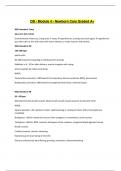OB - Module 4 - Newborn Care Graded A+
WDL Newborn Temp
36.5-37.5 (97.7-99.5)
Environmental influences, Crying may ↑ temp; If hyperthermic, unwrap and check again, if hypothermic
put infant skin to skin with mom with warm blanket, or under warmer and recheck
WDL Newborn HR
120-160 bpm
apical pulse
80-100 beats/min (sleeping) to 160 beats/min (crying)
Stabilizes in 8 - 10 hrs after delivery, may be irregular with crying
Some hospitals do initial rectal temp
NWDL:
Tachycardia: persistent, ≥180 beats/min (respiratory distress syndrome [RDS]; pneumonia)
Bradycardia: persistent, ≤80 beats/min (congenital heart block, maternal lupus)
WDL Newborn RR
30 - 60 bpm
Bilateral bronchial breath sounds, Moist breath sounds may be present shortly after birth
NWDL:
Apneic episodes: >20 s (preterm infant: rapid warming or cooling of infant; CNS or blood glucose
instability)
Bradypnea: <30/min (maternal narcosis from analgesics or anesthetics, birth trauma)
Tachypnea: >60/min (RDS, transient tachypnea of the newborn, congenital diaphragmatic hernia)
Breath sounds:
Crackles (coarse), rhonchi, wheezing
Expiratory grunt (narrowing of bronchi)
Distress evidenced by nasal flaring, grunting, retractions, labored breathing
,Stridor (upper airway occlusion)
Newborn Pain Scales
NIPS, CRIES, FLACC
WDL BP
70/45 - 50/30
may vary by hospital
NOT ROUTINELY DONE UNLESS OTHER VS are not WNL. Bradycardia, tachycardia, irregular or murmur
present,
Varies with change in activity level
Appropriate cuff size important for accurate reading
NWDL:
Difference between upper and lower extremity pressures (coarctation of aorta)
Hypotension (sepsis, hypovolemia)
Hypertension (coarctation of aorta, renal involvement, thrombus)
Initial Newborn Assessment - Overall
Do more annoying/irritating things LAST: temp, measurements and reflexes
color - pink, pale, acrocyanosis, jaundice
Skin condition - Umbilical cord, lesions or rashes
Activity, tone, sleep-wake
Newborn nutrition - Intake (method) & Output,
Daily weights changes- % change from birth weight,
Transcutaneous bilirubin
parent ed & attachment
WDL Term Birth Weight
2700-4000 g (6-9 lb)
Acceptable weight loss: 5%-10% or less in first 3-5 days
should regain birth weight by 2 wks
WDL Term Birth Length
48 - 53 cm (19 - 21 in.)
, WDL Head Circumference
32.5 - 37.5 cm (12.5 - 14.5 in.)
Transition
period of 3 stages during which the NB is becoming physiologically independent
First 6-8 hrs most critical
Transition: First Stage
Period of Reactivity
up to 60 min post-birth
- alert, spontaneous startle, tremors, crying, head movements from side to side
- Bowel sounds are audible and meconium may be passed
- Initial HR can be 160-180 bpm, Decreasing to 100-120 bpm after 30 minutes
- Respiratory rate 60-80 with normal variations: irregular rate, fine crackles, grunting, nasal flaring, and
retractions may occur but should resolve within the 1st hour after birth
Infant Feeding Cues:
Initiate breastfeeding as soon as VS stable
- Hand-to-mouth/Hand-to-hand
- Sucking motions
- Rooting
- Mouthing
Transition: Second Stage
↓ Responsiveness
Hours 1-2 post-birth; ~@hour 2 post-birth
pink color, with unlabored respirations up to 60/min
Bowel sounds audible
Infant sleepy and unlikely to sustain a latch
Transition: Third Stage
Second Period of Reactivity
Hours 2-8 post birth
Can last a few min to several hrs




